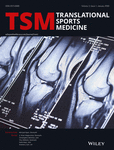Impact of seated and standing positions on triceps surae muscle activation in unilateral Achilles tendon rupture
Abstract
Heel rises are commonly used in the rehabilitation of individuals following Achilles tendon rupture; however, the impact of tendon elongation on triceps surae activation in seated versus standing positions has not been investigated. The purpose of this study was to investigate changes in triceps surae activation during seated compared to standing heel rises in individuals with Achilles tendon rupture and its relationship to tendon elongation. Ten individuals with a history of Achilles tendon rupture were included in this study. Muscle activity using electromyography was examined during a heel rise task in seated (unilateral) and standing (bilateral) positions. Soleus activity was not significantly different between sitting and standing on both the ruptured and uninjured side. On the ruptured, side there were no differences in medial or lateral gastrocnemius activity between sitting and standing; however, on the uninjured side medial and lateral gastrocnemius activity was lower in sitting compared to standing. The results of this study suggest that neuromuscular changes in triceps surae activation occur following Achilles tendon rupture. The seated heel rise position can be used to strengthen all muscles of the triceps surae and is useful when the patient is unable to perform a standing heel rise.
CONFLICT OF INTEREST
Authors report grant funding as disclosed in the acknowledgements. The authors have no additional conflict of interest.




